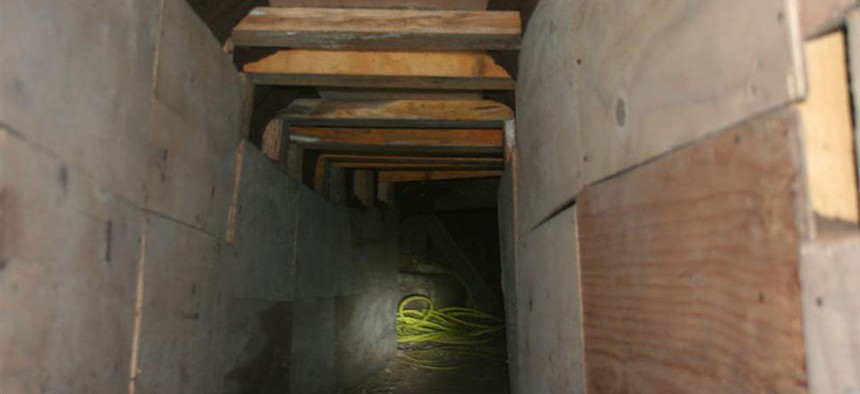Wireless Robots to Comb Illicit Tucson Tunnels for Drugs

U.S. Border Patrol has discovered tunnels such as this 36-foot smuggling tunnel near Tucson. AP file photo
A self-erecting, stair-climbing robot with an arm will scout for drugs along the U.S.-Mexico border.
The Homeland Security Department is ordering wireless robots to probe underground passageways along the Southwest border for drug trafficking activity, according to contracting documents.
The Defense Department for several years has sent robots in place of troops to identify land mines throughout Middle East battle zones, but the technology is relatively new for DHS.
“A robotic solution is always being looked at to replace a Border Patrol agent from having to make initial entry into an illicit tunnel," stated an Aug. 7 report justifying the need for a specific automaton brand, the Pointman. "This has always been a challenge since there is not one single robot solution for various types of illicit tunnels discovered.”
Operators will be able to remotely shrink the rovers to a height of less than 7 inches tall for scouring beneath vehicles and entering confined spaces, such as under beds, according to contract requirements published Aug. 15. The bots also have an “arm” for climbing stairs, they added.
Measuring at most 18 inches tall and 15 inches long, the discreet system will only roam about three miles per hour. It is designed to travel without human intervention for about 200 meters.
Officials claim the Pointman Robot is the only commercial, wireless robot capable of investigating and clearing illegal underground tunnels in Arizona. The “Pointman Robot significantly outperforms all wireless robots evaluated and tested” in the Tucson, Ariz., region, while all the other systems assessed could travel no more than 15 feet before losing control, the justification stated.
Operators can remotely upright a disabled bot “to make corrections after a fall or tip over,” according to the contract requirements.
For trekking along challenging terrain, cluttered with, for example, “clothing, debris/rubble, household items, rocks, stairs, sidewalk curbs, etc.,” the robots can deploy a “traversing” capability, DHS officials said. On flat surfaces, the robots will switch to a wheel mode.
Some passageways are seemingly engineered to block authorities. In 2012, U.S. officials discovered a 755-foot channel descending 57 feet, and located under a 2,000-gallon water tank, according to the Los Angeles Times. It could be moved only by a forklift.
A yet-to-be hired contractor will be responsible for assembling the 17.5 pound autonomous creatures from various commercial parts, including the Pointman and a mini DVR.
Local police in Oklahoma City and Austin have relied on Pointman bots for situations such as standoffs, according to Applied Research Associates, the robot manufacturer.



